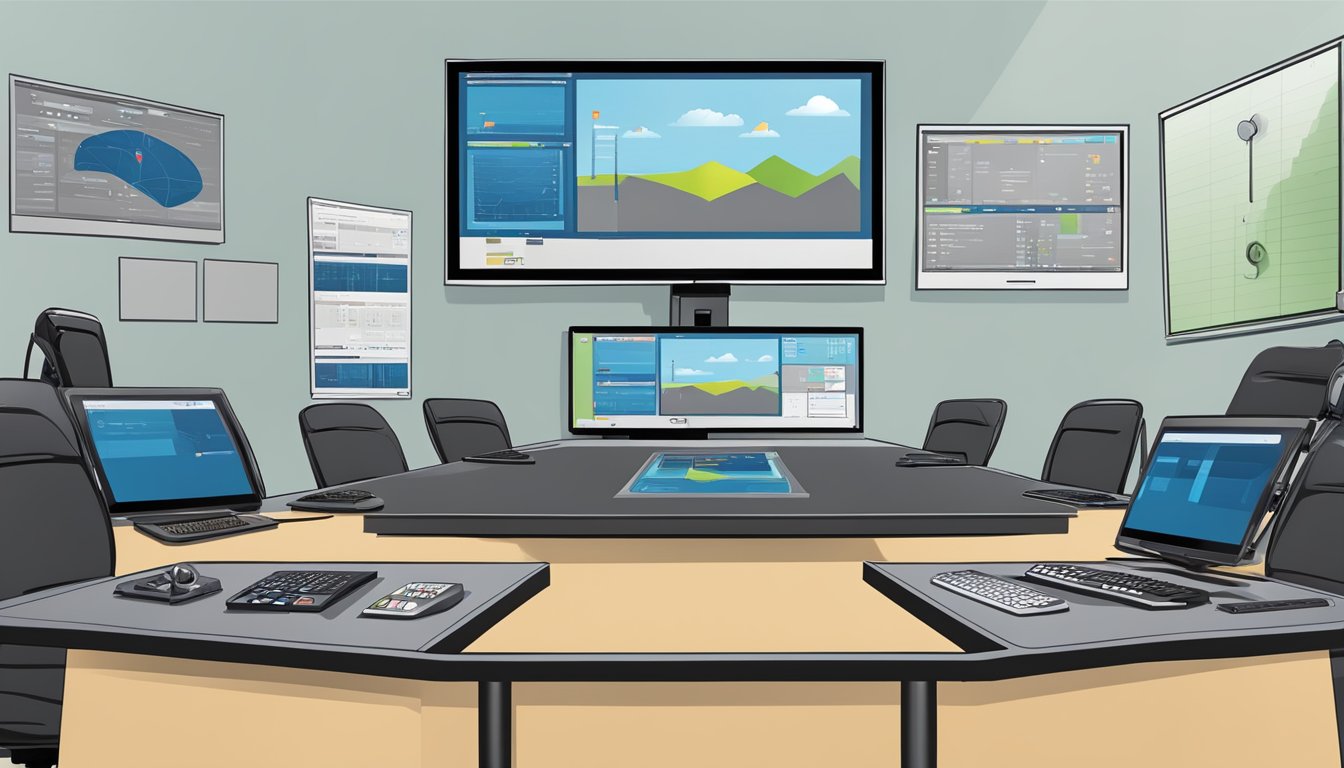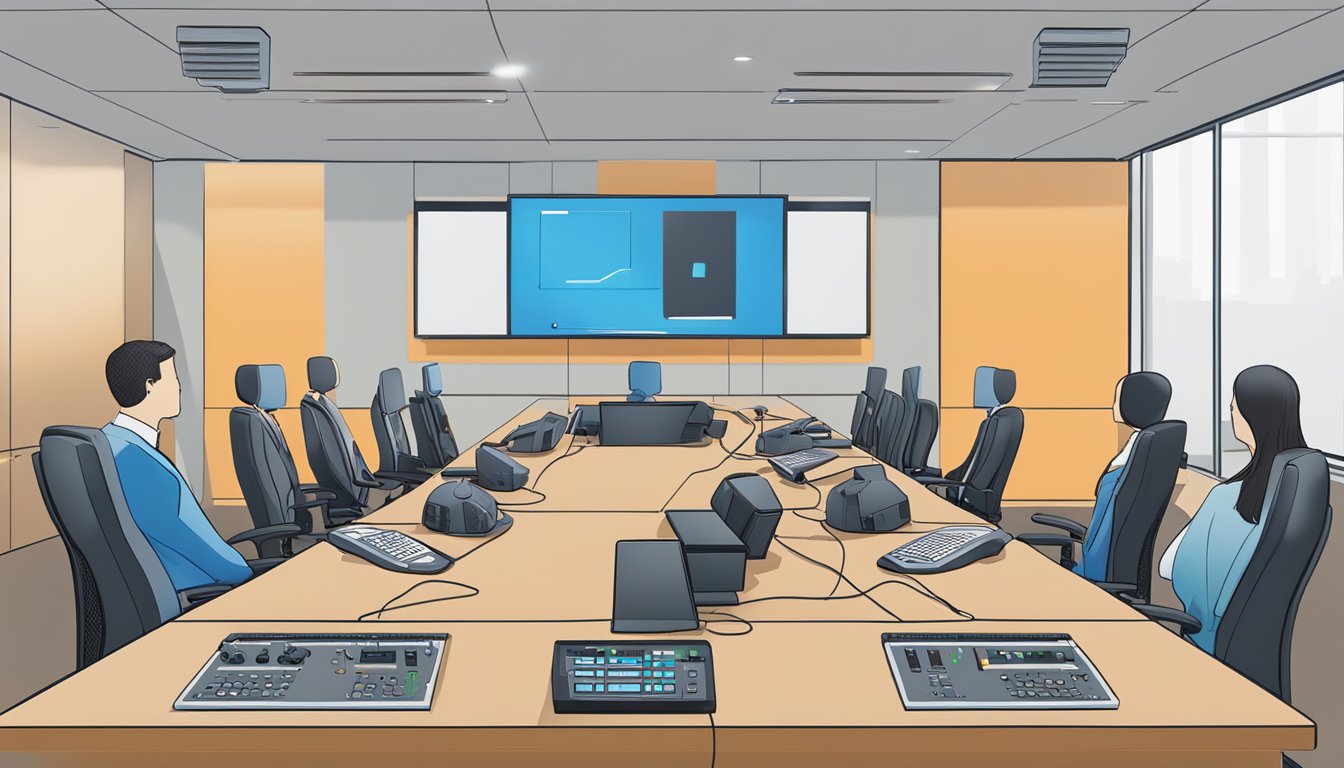Polycom has been a significant player in the audio conferencing sector, offering a range of products that cater to the needs of diverse business environments. Audio conferencing equipment from Polycom is engineered to provide clear, uninterrupted communication for participants irrespective of their location. These devices are designed with advanced technologies that minimize background noise and ensure that the speaker’s voice is transmitted with clarity. The adaptability of Polycom’s equipment makes it suitable for various conference scenarios, from small huddle rooms to large boardrooms, ensuring that every participant can hear and be heard.

The company’s commitment to innovation reflects in its array of audio conferencing solutions, which include features such as high-definition voice quality, 360-degree microphone coverage, and wireless capabilities. Polycom’s SoundStation series, for example, integrates these features to enhance the audio conferencing experience, while its VoiceStation series is optimized for smaller spaces, offering excellent audio quality in a compact form. The durability and ease of use of Polycom products contribute to their popularity among businesses seeking reliable conferencing tools.
In addition to sound quality, Polycom places a strong emphasis on integration and compatibility. Many of its conferencing systems are designed to seamlessly integrate with other communications platforms, such as VoIP and traditional telephony networks, as well as various virtual meeting services. This interoperability is crucial in today’s fast-paced business environment, where flexibility and connectivity are paramount to collaborative work. With Polycom equipment, companies can foster effective communication among teams, clients, and partners, driving forward productivity and decision-making processes.
History of Polycom

Polycom was founded with the vision to transform simple audio communications. Over the years, it has become a leading brand in the telecommunications sector, noted for its innovation, strategic growth, and partnerships.
Early Beginnings and Innovation
Polycom, Inc., was established in 1990 by Brian L. Hinman and Jeffrey Rodman. Their initial product, the SoundStation conference phone, quickly became synonymous with corporate conference rooms worldwide due to its superior sound quality and microphone technology.
Growth and Market Expansion
In the late 1990s and early 2000s, Polycom expanded its offerings to include video and web conferencing solutions. This expansion played a pivotal role in positioning Polycom as a comprehensive provider of unified communication and collaboration tools.
Acquisitions and Partnerships
To enhance its product portfolio, Polycom embarked on a series of acquisitions:
- In 2001, PictureTel was acquired, marking significant growth in Polycom’s video conferencing capabilities.
- Spectralink Corporation, a leader in wireless solutions, was acquired in 2007, which diversified Polycom’s reach into mobility.
Partnerships also contributed to Polycom’s market strength:
- A strategic partnership with Microsoft in 2011 bolstered Polycom’s integration with Microsoft’s communication platforms, improving access to enterprise-level customers.
Understanding Audio Conferencing

In the realm of telecommunication, audio conferencing is a critical tool that enables multiple parties to connect via voice communication. It is essential for facilitating collaboration among geographically dispersed individuals and teams.
Principles of Audio Conferencing
Audio conferencing operates on the foundation that clear, reliable communication can occur between several participants simultaneously, regardless of their location. This is possible through a combination of hardware and software that manages audio inputs and outputs. Key components include:
- Microphones: Capture audio from participants.
- Speakers: Output audio from remote participants.
- Mixers: Balance audio levels to prevent feedback.
- Codecs: Compress and decompress audio data for transmission.
The effectiveness of an audio conference typically relies on:
- Bandwidth: Sufficient network capacity to handle audio data.
- Latency: Minimal delay between transmission and reception of audio.
- Echo Cancellation: Technology that reduces or eliminates audio feedback loops.
Benefits of Quality Audio Systems
Investing in a high-quality audio system ensures:
- Clarity: Reduces background noises and enhances speech.
- Reliability: Minimizes the risk of dropped calls and technical issues.
- Usability: Intuitive interfaces and controls simplify operation for users.
- Integration: Ability to work seamlessly with various communication platforms and devices.
Polycom Conferencing Solutions

Polycom offers a comprehensive portfolio of audio conferencing solutions, each designed to provide crystal-clear communication for meeting spaces of all sizes.
Product Range Overview
The Polycom product line encompasses a variety of audio conferencing equipment, including SoundStation conference phones and VoiceStation units for smaller rooms. Their advanced RealPresence series offers more sophisticated options suitable for large-scale enterprise environments. Polycom ensures compatibility with a range of communication platforms, adapting to diverse user needs.
-
SoundStation Series: Tabletop conference phones providing exceptional voice quality.
- SoundStation IP 7000: Optimized for SIP-based VoIP platforms.
- SoundStation2: Ideal for analog phone lines with traditional telephony features.
-
VoiceStation Series: Compact audio conferencing units perfect for personal or small group use.
- VoiceStation 300: Designed for offices and small meeting rooms with 360-degree coverage.
- VoiceStation 500: Bluetooth-enabled for mobile and internet calling enhancements.
-
RealPresence Series: High-fidelity sound systems tailored for large venues and integrated video conferencing.
- RealPresence Trio: Smart conferencing with content sharing and video integration.
- RealPresence Group Series: Flexible solutions for boardrooms, including immersive telepresence experiences.
Features and Technologies
Polycom’s conferencing equipment is imbued with HD Voice technology to produce lifelike audio fidelity across its product range. Noise-reduction algorithms and advanced echo cancellation ensure clear conversations without distractions. They implement Acoustic Clarity Technology to facilitate simultaneous speaking and listening, significantly optimizing the conference call experience.
- HD Voice Technology: Provides high-definition sound for natural, immersive conversations.
- Noise Reduction: Minimizes background noise to keep the focus on the spoken word.
- Acoustic Clarity Technology: Delivers full-duplex capabilities, allowing overlapping dialogue without dropouts.
- Expandability Options: Certain models allow for additional microphones to cover a larger area.
- Integration Flexibility: Solutions are compatible with a swath of platforms, from analog to VoIP and video conferencing systems.
The commitment to innovation and quality is evident in the breadth of Polycom’s audio conferencing equipment. They continue to pave the way in facilitating effective communication strategies for businesses globally.
Setting Up Polycom Equipment

Setting up Polycom audio conferencing equipment involves a clear process that ensures compatibility and seamless integration with existing systems.
Installation Process
The installation of Polycom equipment begins by unpacking the device and verifying that all components are present. Users should follow these steps:
- Position the main unit: Place it centrally on a conference table or mount it on the wall, as required.
- Connect the cables: Plug the power cable into an outlet and connect the ethernet cable to the LAN port for network access.
- Attach microphones and speakers: For units with external microphones, connect them to the appropriate ports.
- Turn on the unit: Press the power button to initiate the boot-up sequence.
- Configure the device: Follow the on-screen prompts or use the web interface to set language, time settings, and network configurations.
Compatibility and Integration
Ensuring that Polycom equipment works well with other systems is crucial for effective audio conferencing.
- Compatibility Checks: Verify that the Polycom device supports the existing office network protocols and hardware.
- Integration Steps:
- Software updates: Update the device’s firmware to the latest version for optimal performance and compatibility.
- Conference platform integration: Input credentials and settings for platforms like Skype for Business, Zoom, or Cisco Webex.
- Testing: Conduct test calls to confirm that the equipment interfaces properly with other conferencing tech and delivers clear audio.
Operating Polycom Systems
Polycom audio conferencing systems are designed for intuitive use and high-quality audio output. They feature advanced technology that requires understanding of their interface and troubleshooting methods for optimal operation.
User Interface and Controls
Polycom systems are equipped with a user-friendly interface that allows users to manage calls with ease. They typically include a central console with a clear display showing call information, touch-sensitive buttons, and dynamic soft keys. Users can start, join, and control conference calls by pressing corresponding buttons—Mute, Volume, and Call Control. Additionally, most systems have a Menu button taking users through setup options and various configurations.
Audio Optimization and Troubleshooting
Effective troubleshooting ensures consistent audio quality during calls. Users should:
-
Check Connections: Ensure all cables are securely connected to the Polycom unit and the phone line or network.
-
Adjust Settings: Use the Menu options to optimize audio settings for the environment, adjusting microphone sensitivity and speaker volume as needed.
If issues persist, users may perform a system reset or consult the Polycom support for further assistance. This could involve checking firmware updates or specific audio configurations to address common issues such as echo or feedback.
Polycom in Different Environments
Polycom audio conferencing equipment is renowned for its versatility and is commonly found enhancing communication in both professional and institutional settings.
Corporate Use Cases
In the corporate realm, Polycom devices facilitate seamless communication within boardrooms, meeting spaces, and even in individual offices. Multinationals often rely on Polycom’s advanced audio technologies for global calls and virtual meetings to ensure crisp, clear sound transmission. They typically employ models like the Polycom SoundStation, which integrates with various Unified Communications platforms for a cohesive experience across offices.
- Boardroom: Large-scale devices with advanced noise cancellation and microphone sensitivity.
- Small Offices: Compact solutions that are easily transportable between spaces.
- Unified Communications Integration: Devices working in conjunction with UC platforms for streamlined operations.
Educational and Government Applications
Polycom’s audio conferencing tools are equally pivotal in education and government contexts, where they must regularly support large-scale broadcasts and daily administrative operations. Educational institutions utilize these systems to connect classrooms to remote experts, facilitating cross-institution collaboration or virtual guest lectures. Government agencies benefit from Polycom’s secure conferencing capabilities to conduct confidential remote discussions and cross-departmental meetings.
- Virtual Learning: Conferencing units that deliver clear audio and are simple for educators to operate.
- Government Security: High-security devices that cater to sensitive information exchanges.
Connectivity and Network Considerations
Choosing the right connectivity options and ensuring secure network configuration are critical for the optimal performance of Polycom Audio Conferencing Equipment.
Wired vs Wireless Connections
Polycom’s conferencing solutions are designed to facilitate both wired and wireless modes of connectivity. Wired connections, typically through Ethernet cables, offer stability and reliability, with a reduced risk of interference. On the other hand, wireless connections provide flexibility and ease of setup, as they eliminate the need for physical cabling but may be subject to variability in connection quality due to factors like signal strength and network congestion.
-
Wired Connectivity Pros:
- Stable data transmission
- Lower latency
-
Wired Connectivity Cons:
- Less mobility for devices
- Requires cable management
-
Wireless Connectivity Pros:
- Easy to move equipment
- No physical cables needed
-
Wireless Connectivity Cons:
- Risk of interference
- Potentially less stable connection
Network Configuration and Security
Properly configuring the network settings is essential for Polycom audio conferencing equipment to function securely and efficiently. Administrators should ensure that network ports are correctly configured and that firewall settings are adjusted to permit audio traffic. Prioritizing audio traffic through Quality of Service (QoS) settings can greatly enhance performance by reducing latency and packet loss during conferences.
-
Security Measures:
- Implement encryption to protect data
- Use strong authentication methods to prevent unauthorized access
-
Configuration Best Practices:
- Set up a dedicated VLAN for conferencing to segregate and prioritize traffic
- Regularly update firmware and software to address security vulnerabilities
Future of Audio Conferencing
Audio conferencing is poised to undergo significant advancements, influenced by emerging trends and technologies that promise enhanced experiences. Polycom, a leader in the field, is expected to play a pivotal role in these developments.
Emerging Trends and Technologies
In the realm of audio conferencing, emerging technologies are shaping how people will communicate in the coming years. Voice quality is predicted to improve with advancements in noise-cancellation algorithms, making calls sound as clear as in-person conversations. The integration of Artificial Intelligence (AI) will see smarter conferencing systems that can differentiate between voices, automate meeting minutes, and provide real-time translations.
- 3D Audio: Expect to see more immersive sound experiences that mimic real-life interactions.
- Voice-Activated Assistants: Systems may come equipped with virtual assistants for hands-free controls.
Polycom’s Role in Future Developments
Polycom’s contributions to the next wave of audio conferencing tools will likely be substantial. They have a history of incorporating innovative features that enhance the user experience. For example, the company’s integration of HD Voice technology has already set a high standard for audio clarity.
- Investment in R&D: Polycom is expected to continue to invest significantly in research and development.
- Collaboration with Tech Companies: Strategic partnerships with other tech leaders could lead to the adoption of Polycom’s technology in a variety of platforms and applications.
Polycom’s commitment to improving audio conferencing is reflected in its constant push for higher quality and more user-friendly products. As they adapt to and adopt emerging trends, their role in shaping the future of audio conferencing equipment remains crucial.
Support and Resources
Polycom offers a comprehensive support system and a wealth of resources designed to resolve issues swiftly and enhance user proficiency with their audio conferencing equipment.
Technical Support Services
Polycom’s Technical Support Services are structured to provide customers with the assistance they need to maintain optimal system performance. Immediate Assistance is available through a 24/7 support helpline, wherein customers can speak directly with experienced technical support engineers. For non-urgent issues, a Support Portal is accessible for submitting service requests and tracking their resolution status.
| Support Option | Availability | Contact Method |
|---|---|---|
| Helpline | 24/7 | Phone Call |
| Support Portal | 24/7 (Self-service) | Online Ticket Submission |
Training and Documentation
Polycom prioritizes knowledge empowerment for their users. User Training is available in various formats, including live webinars, in-person workshops, and on-demand online videos, to cater to different learning preferences. Resource Documentation comprises detailed user guides, technical datasheets, and frequently asked questions (FAQs), which are meticulously curated for both novice and experienced users.
-
Training Format Examples:
- Webinars
- Workshops
- On-demand Videos
-
Documentation Types:
- User Guides
- Technical Datasheets
- FAQs
Comparative Analysis
This section provides a focused analysis on the performance of Polycom audio conferencing equipment in comparison to its market competitors and evaluates the cost versus benefits of investing in their technology.
Polycom vs Competitors
Polycom’s offerings are renowned for their high-quality audio output and robust construction. One way to discern Polycom’s market position is to compare its features with those of competing brands. Polycom systems, for example, typically include NoiseBlock technology to eliminate distracting sounds, HD Voice clarity, and 360-degree microphone coverage. Competitors such as Cisco and Logitech also offer high-definition audio and multiple microphone arrays, but Polycom often leads in terms of the seamless integration of their noise-cancellation technologies.
- Polycom:
- NoiseBlock technology
- HD Voice
- 360-degree microphone coverage
- Cisco:
- Full-duplex audio
- Directional microphones
- Logitech:
- Wideband audio
- Acoustic echo cancellation
Cost-Benefit Considerations
When considering the financial implications of choosing Polycom over its competitors, it is important to assess both the upfront cost and potential longevity of the equipment. Polycom devices may come with a higher initial price tag, but they often provide savings over time due to their durability and lower need for replacements or repairs.
- Initial Costs: Polycom products generally have a higher purchase price compared to some competitors.
- Longevity and Durability: Reduced replacement and maintenance costs.
- Audio Quality: Possibility of improved communication can lead to increased productivity.
Comparing the total cost of ownership, including purchase price, maintenance, and potential productivity gains, Polycom devices may prove to be a cost-effective choice in the long term for many organizations.
Customer Reviews and Case Studies
Polycom’s audio conferencing equipment is favored for its sound quality and reliability, as evidenced by customer testimonials and objective case studies.
Customer Testimonials
- Consistent Performance: Numerous customers have praised the Polycom SoundStation series for its crystal-clear audio, citing how voices come through naturally in large conference rooms.
- Ease of Use: The intuitive user interface of the Polycom Trio is often highlighted in reviews, with users appreciating the ability to connect and start meetings quickly without technical hurdles.
- Connectivity Options: The flexibility offered by Polycom’s VoiceStation for connecting via Bluetooth or IP networks has received positive comments, especially from users with diverse conferencing needs.
Case Studies
- Increased Productivity: A case study involving a global enterprise revealed that by integrating Polycom’s audio solutions, their teams experienced a 30% reduction in conference setup times, directly enhancing productivity.
- Cost Savings: A financial services firm reported substantial cost savings after switching to Polycom, with a noted decrease in travel expenses and downtime thanks to reliable remote communication.
| Case Study | Impact |
|---|---|
| Global Enterprise | 30% faster conference setup |
| Financial Services | Decreased travel costs |
Through these user experiences, it is evident that Polycom’s conferencing solutions stand out in the market for their consistent quality and adaptability to various business communication demands.
Purchasing and Investment Tips
When considering Polycom Audio Conferencing Equipment, one should assess their specific needs to ensure an adequate return on investment. The selection process involves understanding the scale of the operation. For small meeting rooms, a simpler setup may suffice, whereas larger spaces may require advanced features like noise cancellation and high-fidelity sound.
Budgeting: Budget is crucial and should align with the goal of the purchase. High-quality equipment often leads to better performance, but it’s important to balance cost with features.
Compatibility: Ensure the equipment integrates with the existing infrastructure. Compatibility with various communication platforms and devices is key.
| Feature | Priority | Note |
|---|---|---|
| Sound Quality | High | Crystal clear audio is non-negotiable in conferencing. |
| Microphone Range | Medium | Select a model that suits room size. |
| Connectivity Options | High | Compatibility with multiple devices is essential. |
| Durability | Medium | Invest in robust equipment for longevity. |
Before buying, consulting with IT professionals can provide insights into the best options for a company’s particular communication needs. They analyze the number of users, types of meetings, and room acoustics.
Long-Term Considerations: Think long-term and consider future expansions. A slightly higher initial cost might prove economical in the long run if the equipment can scale with growing needs.
Warranty and Support: Always check for warranty periods and the support offered by the provider. Adequate support reduces downtime and ensures smoother operations.
Testing the equipment before finalizing the purchase helps to identify any issues with audio quality or connectivity. One can often request a demo unit from the vendor for this purpose.
